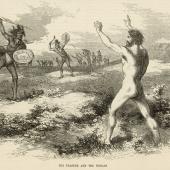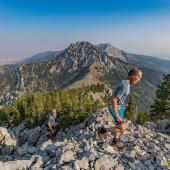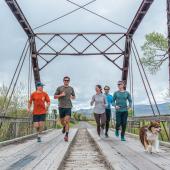Ridge Run Resolution
A local runner goes for broke.
The ball has dropped, the champagne bubbles have gone flat, and all that remains are your daunting resolutions: quit smoking, lose weight, read more, travel abroad, save money. While I usually believe that New Year's resolutions are just delusional cleansings, this year I succumbed to the peer pressure and made my own goal: do the Bridger Ridge Run. The race, emblematic of strength, determination, and pain, gives any finisher the right to claim victory over the range that looms above our mountain community day after day. Difficult? I can't even imagine. Delusional? Absolutely.
And so I have eight months to prepare physically and mentally for a race that will undoubtedly break me into pieces and push me to my limit, with no choice but to begin training in the blustery, frigid, dark days of January. Venturing out into the extreme elements to start the car is bad enough, let alone willingly exerting energy on a jog. But as someone who started running in Fargo, North Dakota (yes, it's really place, and not just a Cohen brothers invention), I can assure you that winter running in Montana could be worse.
Searching for a reasonable (i.e., bearable) training regimen for the Ridge Run, I sought the advice of long-time runners Casey Jermyn, owner of Bozeman Running Company, and Lisa Verwys, co-president of the Big Sky Wind Drinkers. Their excitement about winter running worried me at first, but it didn't take long before they inspired me to throw on a windbreaker and brave the cold. Although Jermyn is far from a novice like me and other victims of their own resolutions, he sympathizes with anyone who has the willpower and ambition to run during the winter.
"The hardest part is getting out the door," he says. "That's the biggest challenge; that's my biggest challenge. But if you can get past the first four or five minutes, it feels great." Yes, it's cold and dark, Jermyn says, but, "as a workout, running gives you the biggest bang for your buck, and anyone can do it." Take a few precautions and every level of runner can have an enjoyable—or at least partially successful—run.
Don't Sweat It—Less Is More
One of the most common mistakes runners make in the winter is to pile on puffy, down-filled clothes paired with thick hats and gloves, making for a sweaty, miserable, and unnecessarily exhausting run. "Don't overdress," Verwys stresses. Focus on light layers that include a base layer, a half-zip, and an outer layer if necessary. Then, "throw on a hat and gloves and you can handle any Bozeman conditions," Jermyn says.
Slip Slidin' Away...
A few years ago, not even three steps out the front door on a short run, I was ass over teakettle, legs in the air cartoon style, from slipping on the ice. I slipped and I slid, and I still didn't learn until recently that traction aids are the way to go in the winter. Verwys stresses the importance of traction aids on running shoes, such as Yaktrax, Diamond Trekkers or Kahtoola Microspikes, for snow and ice, but the brand and type vary according to conditions and personal preference. My co-worker Jess Bleehash, an avid runner and former personal trainer, explains traction in layman's terms: "If the snow is crunchy, you're fine."
Be Seen or Be Hit
When I asked fellow runners and experts about winter safety, I expected to hear about proper shoes, warm clothes, or hydration. I did not expect to be lectured on the importance of reflective gear by all of them. Jermyn and Verwys both say they have had several near misses from cars that lost control on the ice, and both runners believe that their lights and reflective clothing saved them by giving the driver a chance to see them and steer out of the way. With the high cost of fancy shoes and high tech running clothes, reflective gear is surprisingly inexpensive. Ten dollars to save your life? Worth it.
Set an Attainable Goal
Vowing to work out and run more often is a common New Year's resolution, but Verwys cautions not to aim too high or you'll set yourself up for failure. She says to "aim for one mile, or less. Even walk a mile. Just get in the habit of getting outside in the winter." Following this advice, I decided that throughout this winter, on my overly ambitious goal to finish the Ridge Run, I would set weekly goals for myself. Any longer than that—for example, a full six-month marathon schedule—and I know I would set myself up to miss a day or not meet my mileage, and I'd find it easier to give up rather than catch up. This week: run three times outside, go to a Yoga class, and check out a local trail. The uneven and slippery snow trails will be great training for the environment up on the Ridge.
It's okay to dread leaving the house and it's okay not to fall in love with running. But get out and give it a shot, because I'll be out there too, cold and miserable with you. I'll be posting my progress, as well as my trials and tribulations as I begin my eight months of training. Feel free to comment with ideas, questions, or rants about running; I'll need all the help I can get. I have found that getting engaged with the running community is a great way to keep yourself motivated. So the next time you're on a winter jog, look for the girl wearing appropriate layers, Yaktrax, and reflective gear. Then look past her to the girl who has slipped flat on her back yelling curse words—that'll be me.
This is part one of a series about training for, and (hopefully) running the Bridger Ridge Run, by Jenny Sheets.
Read more about running—from gear to fitness to trails—at outsidebozeman.com/activities/running.













